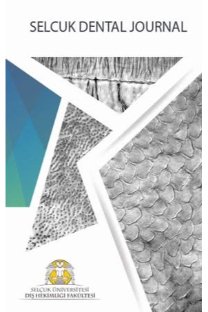Tek kon yönteminin apikal sızıntıyı engelleme yeteneğinin 3 farklı
Apical sealing ability of single-cone technique in canals shaped with three different rotary systems
___
- 1. Kocak MM, Yaman SD. Comparison of apical and coronal sealing in canals having tapered cones prepared with a rotary NiTi system and stainless steel instruments. J Oral Sci 2009;51(1):103-7. Tek kon yönteminin apikal sızıntıyı engelleme yeteneği Cilt 21 • Sayı 1 15
- 2. Qualtrough AJ, Whitworth JM, Dummer PM. Preclinical endodontology: an international comparison. Int Endod J 1999;32(5):406-4.
- 3. Carrotte P. Endodontics: Part 8. Filling the root canal system. Br Dent J 2004;197(11):667-72.
- 4. Chu CH, Lo EC, Cheung GS. Outcome of root canal treatment using Thermafil and cold lateral condensation filling techniques. Int Endod J 2005;38(3):179-85.
- 5. Peters DD. Two-year in vitro solubility evaluation of four Gutta-percha sealer obturation techniques. J Endod 1986;12(4):139-45.
- 6. Holcomb JQ, Pitts DL, Nicholls JI. Further investigation of spreader loads required to cause vertical root fracture during lateral condensation. J Endod 1987;13(6):277-84.
- 7. Gambarini G. The K3 rotary Nickel titanium instrument system. Endodontic Topics 2005;10:179-82.
- 8. Sathorn C, Palamara JE, Messer HH. A comparison of the effects of two canal preparation techniques on root fracture susceptibility and fracture pattern. J Endod 2005;31(4):283-7.
- 9. Horsted-Bindslev P, Andersen MA, Jensen MF, Nilsson JH, Wenzel A. Quality of molar root canal fillings performed with the lateral compaction and the single-cone technique. J Endod 2007;33(4):468-71.
- 10. Yilmaz Z, Tuncel B, Ozdemir HO, Serper A. Microleakage evaluation of roots filled with different obturation techniques and sealers. Oral Surg Oral Med Oral Pathol Oral Radiol Endod 2009;108(1):124-28.
- 11. Mahera F, Economides N, Gogos C, Beltes P. Fluid-transport evaluation of lateral condensation, ProTaper guttapercha and warm vertical condensation obturation techniques. Aust Endod J 2009;35(3):169-73.
- 12. Beatty RG. The effect of standard or serial preparation on single cone obturation. Int Endod J 1987;20(6):276-81.
- 13. Monticelli F, Sword J, Martin RL, Schuster GS, Weller RN, Ferrari M, et al. Sealing properties of two contemporary single-cone obturation systems. Int Endod J 2007;40(5):374-85.
- 14. Pashley DH, Depew DD. Effects of the smear layer, Copalite, and oxalate on microleakage. Oper Dent 1986;11(3):95-102.
- 15. Wu MK, De Gee AJ, Wesselink PR, Moorer WR. Fluid transport and bacterial penetration along root canal fillings. Int Endod J 1993;26(4):203-08.
- 16. Wu MK, De Gee AJ, Wesselink PR. Fluid transport and dye penetration along root canal fillings. Int Endod J 1994;27(5):233-38.
- 17. Thompson SA, Dummer PM. Shaping ability of Lightspeed rotary nickel-titanium instruments in simulated root canals. Part 1. J Endod 1997;23(11):698-702.
- 18. Ahlquist M, Henningsson O, Hultenby K, Ohlin J. The effectiveness of manual and rotary techniques in the cleaning of root canals: a scanning electron microscopy study. Int Endod J 2001;34(7):533-37.
- 19. Glossen CR, Haller RH, Dove SB, del Rio CE. A comparison of root canal preparations using Ni-Ti hand, Ni-Ti engine- driven, and K-Flex endodontic instruments. J Endod 1995;21(3):146-51.
- 20. Gomes BP, Pinheiro ET, Sousa EL, Jacinto RC, Zaia AA, Ferraz CC, et al. Enterococcus faecalis in dental root canals detected by culture and by polymerase chain reaction analysis. Oral Surg Oral Med Oral Pathol Oral Radiol Endod 2006;102(2):247-53.
- 21. Gordon MP, Love RM, Chandler NP. An evaluation of .06 tapered gutta-percha cones for filling of .06 taper prepared curved root canals. Int Endod J 2005;38(2):87-96.
- 22. Tasdemir T, Er K, Yildirim T, Buruk K, Celik D, Cora S, et al. Comparison of the sealing ability of three filling techniques in canals shaped with two different rotary systems: a bacterial leakage study. Oral Surg Oral Med Oral Pathol Oral Radiol Endod 2009;108(3):e129-34.
- 23. Zmener O, Pameijer CH, Macri E. Evaluation of the apical seal in root canals prepared with a new rotary system and obturated with a methacrylate based endodontic sealer: an in vitro study. J Endod 2005;31(5):392-95.
- 24. Wu MK, van der Sluis LW, Wesselink PR. A 1-year followup study on leakage of single-cone fillings with RoekoRSA sealer. Oral Surg Oral Med Oral Pathol Oral Radiol Endod 2006;101(5):662-67.
- 25. Pommel L, Camps J. In vitro apical leakage of system B compared with other filling techniques. J Endod 2001;27(7):449-51.
- 26. Yucel AC, Ciftci A. Effects of different root canal obturation techniques on bacterial penetration. Oral Surg Oral Med Oral Pathol Oral Radiol Endod 2006;102(4):e88-92.
- 27. da Silva Neto UX, de Moraes IG, Westphalen VP, Menezes R, Carneiro E, Fariniuk LF. Leakage of 4 resin-based root-canal sealers used with a single-cone technique. Oral Surg Oral Med Oral Pathol Oral Radiol Endod 2007;104(2):e53-57.
- 28. Orstavik D, Nordahl I, Tibballs JE. Dimensional change following setting of root canal sealer materials. Dent Mater 2001;17(6):512-19.
- 29. Saleh IM, Ruyter IE, Haapasalo MP, Orstavik D. Adhesion of endodontic sealers: scanning electron microscopy and energy dispersive spectroscopy. J Endod 2003;29(9):595- 601.
- ISSN: 1300-5170
- Yayın Aralığı: Yılda 3 Sayı
- Başlangıç: 1991
- Yayıncı: İsmail Marakoğlu
Conservative treatment of dentigerous cysts in children: A case report
Gülsüm YILDIRIM, Ayşe SELÇUK, Gül TOSUN, Celal IRGIN, Doğan DOLANMAZ
Comparative efficacy of butamben, iodoform, eugenol mixture
Gülsüm YILDIRIM, Celal ÇANDIRLI, Dilek MENZİLETOĞLU KIZILOĞLU, Ahmet MİHMANLI, Doğan DOLANMAZ
İki farklı; fiberle güçlendirilmiş inley köprü sisteminin kırılma
Third molar agenesis in hypodontia patients
A. Pınar SÜMER, Kaan GÜNDÜZ, Soner ÇANKAYA
Farklı kök güçlendirme yöntemleri ile restore edilmiş immatür
MELEK AKMAN, Sema BELLİ, Özlem DOYDUK KAHVECİ, Ayçe ELDENİZ ÜNVERDİ
Tek kon yönteminin apikal sızıntıyı engelleme yeteneğinin 3 farklı
Erhan ÖZCAN, İsmail Davut ÇAPAR, Özlem KOYDUK KAHVECİ, Hale ARI
Dilaceration of maxillary incisors: Two case reports
Mustafa ALTUNSOY, EMRE KORKUT, Murat Selim BOTSALI, Gül TOSUN
Hızlandırılmış yaşlandırma sonrası kompozit rezin simanların
Nuri Murat ERSOY, Bülent KESİM
Ceyhun ARICIOĞLU, Hanife ATAOĞLU
Fiber ile güçlendirilmiş kompozit (FRC) post yüzeyine rezin
Betül ÖZÇOPUR, Andaç Barkın BAVBEK, KEZBAN ÇELİK, Meltem ÖZER, Gürcan ESKİTAŞCIOĞLU
